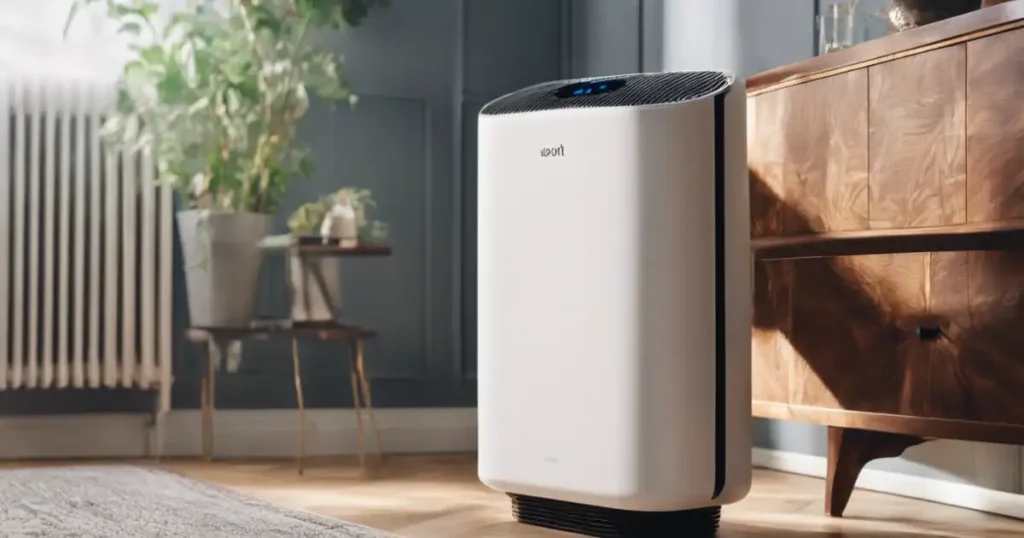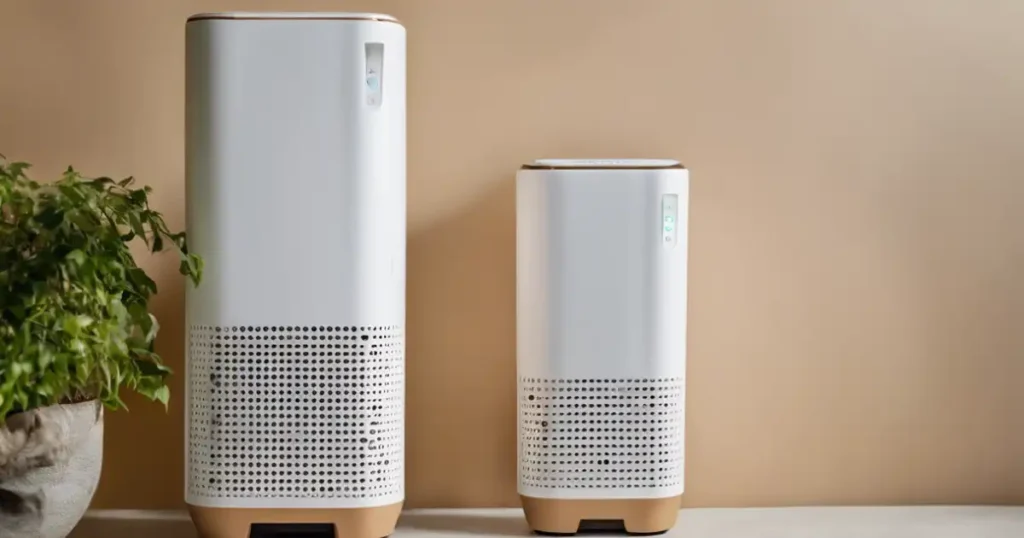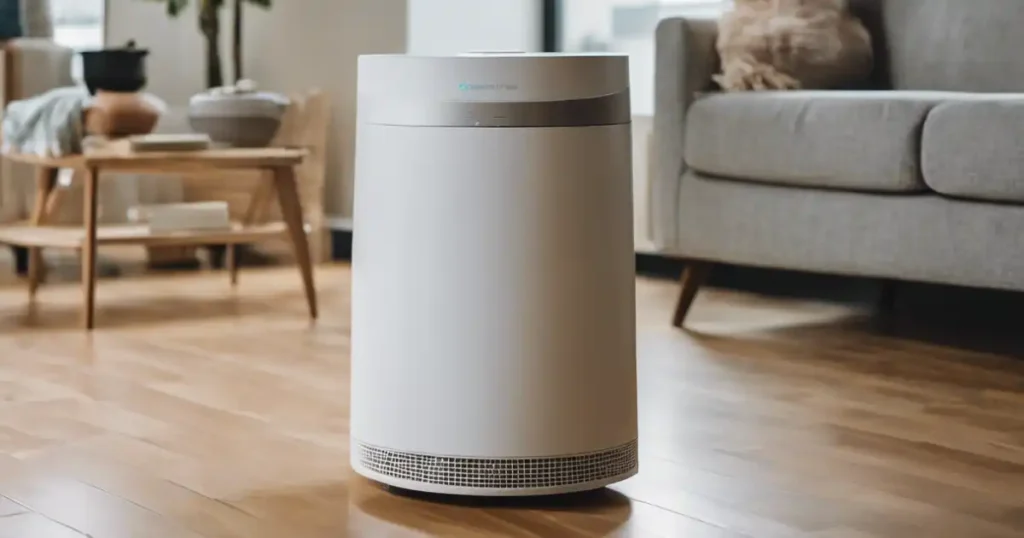What if the key to breathing in cleaner air lies not in just one air purifier but in the strategic placement of several? That’s why many people have this pressing question: How Many Air Purifiers Do I Need?
So, the exact number depends on several factors. Generally, a solid, top-notch air purifier that’s just the right size can handle a regular-sized room. However, larger spaces or areas with poor air quality may require additional units or a more powerful purifier.
Keep reading to get the answer to all these questions:
- Do You Need an Air Purifier In Every Room?
- Can One Air Purifier Clean an Entire House?
- What Size Air Purifier Do I Need?
So, let’s dive in!
How Many Air Purifiers Do I Need?
How many air purifiers does your house need? It’s not a one-size-fits-all answer, and various factors come into play.
1. Home Size and Layout
Large homes with open floor plans spanning a thousand square feet or more will need more than one air purifier for complete coverage. The number and placement depend on how openly connected or closed off each space is.
Let’s break it down further:
– Square Footage Matters:
Consider the total square footage of your home. Different purifiers are designed for varying coverage areas. Here’s a rough guideline to help you get started:
| Home Size | Recommended Air Purifier |
|---|---|
| Small (Up to 500 sq. ft.) | 1 Purifier |
| Medium (500 – 1,000 sq. ft.) | 1-2 Purifiers |
| Large (1,000 – 2,000 sq. ft.) | 2-3 Purifiers |
| Extra Large (2,000+ sq. ft.) | 3 or more Purifiers |
– Room Layout:
The layout of your home influences the circulation of the amount of air. If you have an open floor plan, a centralized air purifier may suffice. However, individual purifiers may be more efficient in homes with multiple rooms and partitions.
– Multiple Stories:
If your home spans multiple stories, consider placing multiple purifiers on each floor. This is especially important if the HVAC system doesn’t circulate air efficiently across levels. Evaluate the layout to ensure comprehensive coverage throughout your home.
2. Air Quality Goals
What level of indoor air quality are you aiming for? Do you or your family members experience conditions like asthma, allergies, or other health issues? Establishing clear air purification targets tailored to your situation is vital.
For general wellness and convenience, having at least one air cleaning unit per frequently occupied room is wise. However, individuals with specific health needs might require more extensive coverage. This can be achieved by using medical-grade models in multiple spaces.
3. Occupancy and Activity Levels
Homes with more residents, guests, and pets need added air cleansing support. The number of bodies contributing to indoor pollution build-up plays a significant role. Consider your daily activities and lifestyle. If you cook meals daily, engage in hobbies that release fumes, or follow a fitness routine, these activities contribute to varying levels of indoor pollutants.
For spaces with high occupancy, strategically place air purifiers near potential sources of pollution like kitchens, hobby rooms, and home gyms. This targeted approach ensures efficient purification where it matters most, maintaining a healthier indoor environment.
4. Specific Airborne Contaminants
Does your indoor environment struggle with elevated allergens like pollen, dander, or mold? Do vehicle exhaust fumes seep in from an attached garage? Do you battle tobacco smoke or wildfire ash residue seasonally? Take a close inventory of potential points where particles enter your living space and then consider appropriate solutions.
For instance, placing a high-grade HEPA purifier at the garage entry can filter out car-related chemicals. Preventing mold outbreaks in basements can be achieved with the addition of humidity-regulating dehumidifiers. Understanding your unique air quality weak spots is key to comprehensive protection for a healthier living environment.
5. Health Considerations
For individuals managing health conditions impacted by indoor air particles, an extra layer of caution is crucial. Those dealing with asthma or allergies may find relief through medical-grade air purifiers tailored to remediate specific triggers. Some individuals also opt for specialized UV sterilization to enhance indoor safety against germs and chemicals.
When selecting an air purifier for your home, assess your family’s sensitivities and consult with medical guidance. Choosing the right air purifier becomes a critical aspect of personalized care. For those with heightened health risks, implementing multi-layered solutions across frequently inhabited areas proves indispensable for creating a safer and healthier indoor environment.
Do You Need an Air Purifier in Every Room?

Some assume that they can improve indoor air quality by placing air purifiers in every single room. But is that level of saturation necessary? Probably not.
To streamline your approach, prioritize each room in your home. You should place an air purifier where your family spends the most time – such as living rooms, bedrooms and home office spaces. These places witness the highest volume of occupant activity and deserve prime attention.
Next, tackle spaces prone to special pollutants that bother you most. Place units in kitchens containing gas stoves that emit fumes or hobby rooms that collect dust. Don’t forget about basements and attics where mold and mildew thrive.
You likely don’t need units in hallways, storerooms, or garages unless excessive odors or emissions permeate from them. So, you don’t necessarily need an air purifier in every room to achieve improved indoor air quality.
Can One Air Purifier Clean the Whole House?
It’s an alluring idea – positioning one single air purifier in your home and then expecting purified air to every corner. But reality rarely aligns with this one-size-fits-all vision.
Whether a single air purifier can clean the air inside your home depends on various factors. For a house with a compact, simple layout, using a central air purifier may bring noticeable improvements. However, many modern homes have larger and more fragmented layouts with multiple rooms. In such cases, a single air purifier may not be sufficient for comprehensive air improvement.
The main limitation is that most air purifiers only effectively clean the room they are physically placed in. They impact the closely neighboring spaces that receive indirect air circulation. For reference, models made for large rooms up to 800 sq ft likely can’t properly filter much more than 1,000 sq ft total due to airflow constraints.
And remember – air purity notably drops the farther you move away from the machine. So even with a high-end unit in your living room, back bedrooms likely won’t receive the same level of filtration.
Additionally, a lone purifier battles a growing number of pollutants as home size increases. It must work harder across greater square footage. This quickly reduces filter lifespans and increases long-term costs due to frequent replacements.
Is It Better to Have Multiple Air Purifiers?
Yes, having multiple air purifiers distributed in separate rooms is far more effective than a single unit. This strategy provides comprehensive home coverage, allowing more effective targeting of specific areas.
The most noticeable perk is maximizing clean air in the common spaces your family occupies together. For example, placing the unit in both an open kitchen and adjoining room better handles cooking fumes and activity pollution simultaneously.
Strategically targeting different pollutant hot spots is also simpler. You can use one model to focus on eliminating pet dander in bedrooms while another handles kitchen grease or garage dust.
This is especially beneficial in two-story homes where dividing purifiers by floor is convenient. Units on separate levels don’t compete as much to individually push clean air out horizontal doors rather than upstairs.
Lastly, spreading out the workload creates less strain on each machine over time. Units working too aggressively lead to faster wear and tear. Moderating usage preserves product lifespans.
What Size Air Purifier Do I Need?

Size matters, especially when it comes to air purifiers. Choosing the right size for your device is crucial for achieving optimal performance. An undersized purifier may struggle to keep up with the demands of a room. On the other hand, an oversized purifier could be overkill and unnecessarily expensive.
To ensure the highest efficiency of the air purifier, follow these detailed steps to determine the ideal size for your living space:
1. Measure the Room Dimensions:
Begin by meticulously measuring the size of the room where the air purifier will operate. Use a tape measure to precisely record the length, width, and height. Once you have these figures, multiply them to calculate the total volume of the room in cubic feet.
This approach ensures the purifier is the right size for your living space’s unique spatial characteristics.
2. Calculate Air Changes Per Hour (ACH):
Delve deeper into the science of air purification by determining the desired Air Changes Per Hour (ACH). To achieve optimal results, aim for a range of 4 to 6 air changes per hour. This calculation provides insight into how frequently the air purifier can filter and refresh the entire volume of air in the room.
A higher ACH ensures a consistent and thorough purification process, especially in larger areas.
3. Consider the Clean Air Delivery Rate (CADR):
Unlock the technical specifications of your air purifier by referring to the Clean Air Delivery Rate (CADR). This metric indicates the volume of clean air delivered by the purifier in cubic feet per minute (CFM).
For an efficient purification process, the CADR should ideally match the ACH requirement for your specific room size. This step fine-tunes your selection based on the purifier’s actual performance capabilities.
4. Adjust for Pollutant Sources:
Recognize the unique challenges posed by specific pollutant sources in your environment. If your room hosts activities such as cooking or is frequented by pets, adjust the recommended CADR accordingly.
Many manufacturers offer specific CADR adjustments based on the types of pollutants present. This ensures that your air purifier is designed to deal with the specific pollutants that may be present in your living space.
5. Factor in Ceiling Height:
Elevate your precision by factoring in the often-overlooked ceiling height. The height of the room directly impacts the total volume of air. Most air purifiers are made for standard ceiling heights, so if your room is different, adjust the purifier size accordingly.
This meticulous adjustment ensures the purifier cleans all the air in your house from top to bottom.
6. Check Manufacturer Recommendations:
Navigate the sea of options by consulting the manufacturer’s recommendations. Manufacturers usually provide guidelines for recommended room sizes for each air purifier model.
Cross-reference this information with your room dimensions and pollutant considerations to guarantee alignment. This step adds an extra layer of assurance, aligning your choice with the manufacturer’s recommendation.
7. Consider Your Health Needs:
Elevate the decision-making process by incorporating considerations for personal health needs. If you have specific health concerns like allergies or respiratory issues, choose an air purifier with HEPA air filter.
This proactive choice ensures a more robust filtration process, finely tuned to meet your home’s unique health needs. Investing in a purifier that goes beyond the basic specifications can make a substantial difference in creating a healthier indoor environment.
Tips for Maximizing Your Air Purifier’s Effectiveness:

- Centralized Location: For optimal air purification, think about positioning your air purifier right in the heart of your room. This strategic placement ensures a uniform distribution of purified air, making it particularly effective in rooms with open floor plans.
- Avoid Obstructions: Ensure a clear path for your air purifier by keeping it away from furniture or walls. The unit can efficiently draw in and purify the surrounding air by maintaining unobstructed airflow.
- Near Breathing Zones: Enhance your air purifier’s effectiveness by placing it near commonly used breathing zones—where you sit, work, or sleep. This thoughtful placement ensures that purified air is delivered directly to the areas where you and your family spend the most time.
- Strategic Room Placement: If you have multiple air purifiers, strategically position them in rooms with high occupancy, such as living rooms, bedrooms, or home offices. This targeted placement prioritizes air quality in spaces that are frequently in use.
- Avoid Drafts and Direct Sunlight: Optimize your air purifier’s performance by keeping it away from drafts and direct sunlight. Placing it near windows or vents can disrupt airflow patterns, potentially affecting its overall efficiency.
- Elevated Position: Consider giving your air purifier a boost by placing it in an elevated position, like on a table or shelf. This positioning helps the unit efficiently circulate purified air throughout the room, reaching a wider area for maximum impact.
Conclusion
Finding the right size and number of air purifiers hinges on a tailored approach. There’s no one-size-fits-all answer to “How Many Air Purifiers You Need for Your Space?” The exact answer depends on your home’s size, layout, air quality goals, and specific needs.
For larger homes, open layouts, or areas with heightened air quality concerns, multiple strategically placed purifiers may be beneficial. The size of the purifier matters, too—precise measurements, consideration of air changes per hour, and adherence to manufacturer recommendations are crucial.
You need to consider factors like pollutant sources, ceiling height, and your family’s health for a unique purification strategy for your house. Prioritize frequently occupied spaces and those with specific pollutant concerns.
Ultimately, the goal is not just cleaner air but a healthier, more comfortable living environment. So, take these factors into account, and let the refreshing winds of clean air fill your home.
FAQs
Do you need 2 air purifiers in one room?
If the room is large or has poor air quality, using two air purifiers strategically placed can enhance coverage. For most regular-sized rooms, one well-sized air purifier is generally sufficient. Consider factors like room size, layout, and specific air quality goals when deciding on the number of air purifiers for a particular space.
Is it better to have multiple small air purifiers or one large one?
Using several small air purifiers in strategic locations is often more effective than depending on a single large unit. This method ensures better coverage throughout your home, efficiently addressing specific pollutant sources.
Can you use too many air purifiers?
Yes, it’s possible to use too many air purifiers. However, excessive use may lead to increased energy consumption and unnecessary maintenance costs. It’s important to strike a balance while avoiding unnecessary redundancy.
Where is the best place to put an air purifier?
The best place to put an air purifier depends on your specific needs and room layout. For optimal results, place it in frequently occupied areas like living rooms, bedrooms, or home offices. Also, consider pollutant sources and strategically position the purifier to address those concerns.

